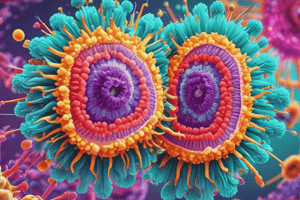Podcast
Questions and Answers
What type of genetic material is found in the influenza virus?
What type of genetic material is found in the influenza virus?
- Double-stranded DNA
- Single-stranded DNA
- Circular RNA
- Single-stranded RNA (correct)
Which glycoprotein is essential for the influenza virus to enter host cells?
Which glycoprotein is essential for the influenza virus to enter host cells?
- Neuraminidase
- Hemagglutinin (correct)
- RNA polymerase
- Capsid protein
What complication can arise as a secondary infection after influenza?
What complication can arise as a secondary infection after influenza?
- Asthma attack
- Cerebral edema
- Pneumonia (correct)
- Lung cancer
What mechanism allows for the spread of the influenza virus within the respiratory tract?
What mechanism allows for the spread of the influenza virus within the respiratory tract?
What is the primary method for laboratory diagnosis of influenza that is considered the gold standard?
What is the primary method for laboratory diagnosis of influenza that is considered the gold standard?
What is a potential consequence of the influenza virus's high susceptibility to mutations?
What is a potential consequence of the influenza virus's high susceptibility to mutations?
How does the influenza virus primarily enter the body?
How does the influenza virus primarily enter the body?
What symptom results mainly from the inflammatory response caused by the influenza virus?
What symptom results mainly from the inflammatory response caused by the influenza virus?
Flashcards
What are the key characteristics of influenza viruses?
What are the key characteristics of influenza viruses?
Influenza viruses are enveloped, negative-sense, single-stranded RNA viruses that belong to the Orthomyxoviridae family. They have a roughly spherical shape, although they can also take on irregular shapes.
What is the role of hemagglutinin (HA) in influenza infection?
What is the role of hemagglutinin (HA) in influenza infection?
Hemagglutinin (HA) is a glycoprotein on the influenza virus envelope that binds to sialic acid receptors on host cells, allowing the virus to enter the cell.
What is the role of neuraminidase (NA) in influenza infection?
What is the role of neuraminidase (NA) in influenza infection?
Neuraminidase (NA) is another glycoprotein on the virus envelope that cleaves sialic acid, facilitating the release of newly formed influenza viruses from infected cells.
How does influenza virus replication affect the host?
How does influenza virus replication affect the host?
Signup and view all the flashcards
What are rapid antigen detection tests (RADTs) used for in influenza diagnosis?
What are rapid antigen detection tests (RADTs) used for in influenza diagnosis?
Signup and view all the flashcards
What is considered the gold standard for influenza diagnosis?
What is considered the gold standard for influenza diagnosis?
Signup and view all the flashcards
In what cases can influenza infection lead to serious complications?
In what cases can influenza infection lead to serious complications?
Signup and view all the flashcards
What is a cytokine storm in the context of influenza?
What is a cytokine storm in the context of influenza?
Signup and view all the flashcards
Study Notes
Influenza Virus Morphology
- Influenza viruses are enveloped, negative-sense, single-stranded RNA viruses.
- They belong to the family Orthomyxoviridae.
- They have a roughly spherical shape, though pleomorphic forms exist.
- The viral envelope is studded with glycoproteins: hemagglutinin (HA) and neuraminidase (NA).
- HA is crucial for viral entry into host cells, binding to sialic acid receptors on the surface of host cells.
- NA facilitates the release of newly formed virions from infected cells by cleaving sialic acid.
- The genome comprises 8 RNA segments, each encoding one or more viral proteins.
- These RNA segments are highly susceptible to mutations, contributing to antigenic drift and shift.
Influenza Virus Pathogenesis
- The virus primarily infects the respiratory tract, starting with the upper respiratory tract (nose, throat).
- Entry of the virus into the body usually takes place through the inhalation of infected droplets produced by coughing or sneezing.
- The virus replicates in the epithelial cells of the respiratory tract.
- Replication causes inflammation and damage to the respiratory surfaces.
- Symptoms of the infection, like fever, cough, sore throat, and muscle aches, are a consequence of the inflammatory response and direct effects of viral replication.
- Viral replication and spread are facilitated by the actions of HA and NA.
- Immune responses, both innate and adaptive, are elicited by viral infection.
- Individuals with compromised immune systems or pre-existing conditions are particularly susceptible to severe complications like pneumonia.
- Secondary bacterial infections can be a serious complication of influenza.
- Cytokine storm may occur in severe cases.
Influenza Virus Laboratory Diagnosis
- Several laboratory methods exist to diagnose influenza virus infection.
- Rapid antigen detection tests (RADTs) are commonly used for quick results. These tests are generally highly sensitive and specific.
- These tests detect viral antigens (HA or NA) in clinical specimens (nasal or throat swabs).
- Molecular assays, such as real-time reverse transcriptase-polymerase chain reaction (rRT-PCR), are highly sensitive and specific for identifying influenza viruses.
- These assays detect viral RNA in clinical specimens. They are considered the gold standard for diagnosing influenza.
- Viral isolation in cell culture is possible but less frequently used due to time constraints and resources required.
- Serological assays, like ELISA, can be used to detect antibodies against influenza viruses in patient samples. These are often employed retrospectively to confirm prior infections or assess immune response.
- Selection of appropriate tests depends on various factors, including the patient's clinical presentation, specimen collection timing, and the resources available.
Studying That Suits You
Use AI to generate personalized quizzes and flashcards to suit your learning preferences.
Description
This quiz covers the morphology and pathogenesis of the influenza virus, detailing its structure, genome, and mechanisms of infection. It highlights the role of glycoproteins in viral entry and release, as well as the processes contributing to mutation and virulence. Test your knowledge on these essential aspects of influenza virology.






